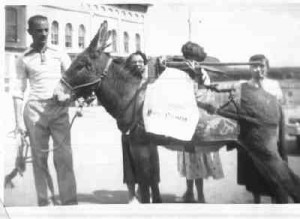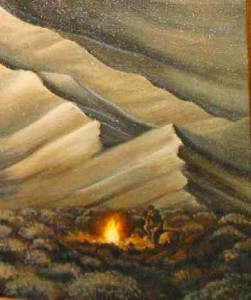Sidebar by Martha Quillen
Water – July 2004 – Colorado Central Magazine
We’ve heard it declared that the Round Mountain Water and Sanitation District once tried to grab all of the groundwater in the Wet Mountain Valley, but that’s not exactly true. In reality, Round Mountain tried to claim the “non-tributary” underground water in the valley.
To understand what really happened, however — and what’s starting to happen through-out our region — you’ve got to know that geologists believe that there are acre feet upon acre feet (or gallons and gallons if you prefer) of unused water in some of Colorado’s valleys.
Theoretically, there are huge amounts of water — far beneath the valley floor and totally separate from the surface water — in confined systems (basins where very little or no water runs out in rivers and streams). So presumably if you sank a well thousands of feet into the ground, you’d reach this deep aquifer, and could tap into a tremendous supply of previously unavailable water.
And Round Mountain was just one of many, many organizations that hoped to make a claim on some of that non-tributary underground water, which is presumably just sitting in a deep aquifer, untapped, unused and ready to be developed.
Even if geologists are right, and this water is actually there — and sweet, rather than contaminated with salts and minerals — traditional water users generally disapprove of claims on it for several reasons. This deep aquifer may not be quite as separate as is thought, in which case surface water supplies could be depleted. Furthermore, if this huge supply actually does exist, and is tapped into by a local entity, it would devalue existing rights (and such deep wells aren’t something that ranchers or even most subdivisions can afford).
Today, however, Round Mountain and other municipal water suppliers no longer have a substantial claim on this water. In 1982, this non-tributary water was up for grabs, but the state has since decided that rights to it should be proportionally divided between surface users — and that’s both good and bad for people who live here.
Now that the law has changed, it takes a land owner with a considerable amount of acreage to claim enough water to make a deep well worthwhile. But that’s what happened in the San Luis Valley. Gary Boyce, manager of a huge parcel of valley property (plus a fourteener), proposed a plan to supply the city of Aurora with non-tributary groundwater, and the resultant protest was loud and vociferous — and somewhat successful.
Those who feared Boyce’s proposal supported the Great Sand Dunes National Park. And with local support, the park became a reality. Now, due to the subsequent acquisition of land and water for the park, the federal government will determine the deep aquifer’s future, and locals believe the feds will protect the water — but there are no guarantees.
Round Mountain’s intentions were a little different, however, and therefore Round Mountain’s claim was a little less risky for local water users than Boyce’s proposal. Even if it turned out that tapping into a deep aquifer diminished surface water, Round Mountain’s water would have stayed in the Wet Mountain Valley and replenished the aquifer.
In fact, residential water users typically consume very little water, so most of what they use either flows from their lawn right back into the ground, or it gets treated, then returned to the system.
Whereas Boyce wanted to supply water to Aurora, and thus the water he claimed would have been piped out of its region of origin forever. So even if Round Mountain’s claim was irksome to rural users, it wasn’t an unmitigated threat.
But as it turns out, the courts have since decided that non-tributary underground water belongs to surface users, and that means most of it actually belongs to those very same rural users who protested. Individual users, however, don’t usually own enough water to matter, but what if they went together and pooled their resources? Could they sell it for big bucks?
Well, if Custer County users wanted to turn a profit, they’d probably have to sell to an entity with far deeper pockets than Round Mountain. Yet selling water outside of their valley would considerably increase their risks of losing their own surface water (if it turned out the aquifer wasn’t entirely separate).
And so it goes.
These fledgling attempts to tap Colorado’s deep aquifers have brought theory, risk, renewed water wars, and a lot of scientific and technical arguments to the table. And at this point, we have no idea whether deep aquifers are a solution to Colorado’s water problems, or a danger.
But we felt obligated to add this tedious water discussion to Rayna’s admirably straightforward piece because this is just the beginning. Many front range cities are running short of water, so claims on non-traditional sources are going to increase — and both municipal and rural users in our region may be threatened.
When towns, water districts, or ditch users clash, there’s a tendency to assume that one of them is right and the other is wrong — in an almost good vs. evil sense. But in actuality, these organizations serve different factions and protect different types of users.
Round Mountain, for instance, served users in Westcliffe and Silver Cliff pretty well by trying to claim non-tributary underground water supplies. But in doing so it angered rural Custer County water users.
And Upper Arkansas tries to protect Central Colorado from front range cities, but in doing so it encourages the rapid development of subdivisions and ranchettes through-out our region. That, however, is a natural consequence of Colorado law which only lets a region keep water if it uses it.
Thus, concerned citizens should not just sit back and trust Upper Ark, Round Mountain, their town, or any other entity to just take care of their water — as some Salida councilmen and reporters have suggested — because no water district can serve everyone.
And unfortunately, front range cities may prove to be less of a threat to local users than other local users. From the very first, when cattlemen and sheepmen started shooting it out, growth within a region — and thus having more water users and more different kinds of users inside of your basin — has diminished supplies. In fact, during our recent drought, it was the user next door who helped your well or ditch go dry — not Aurora. Although, of course, Aurora may soon be trying to buy your neighbor’s water….
In terms of a rosy future, however, perhaps the biggest threat to all users in Colorado, is overappropriation. For quite a while, it has been known that there is more water on paper in Colorado than actually exists. And thus our cities and agricultural users — and even presumably protective governmental agencies like the Upper Arkansas Water Conservancy District which augments new wells — are all buying and selling and thus encouraging the use of more water than actually exists.
And yet our state keeps growing….
To thrive in years to come, Colorado will either have to establish an economy that doesn’t rely on constant growth, or it will need to find more water. And since the only really good jobs in our region are in construction and real estate, we suspect Colorado will opt to find more water.
At this point, non-tributary underground water is a potentially new source of water, which many believe promises an enormous supply which no one — from Kansas to California — is currently using. But unfortunately for us, our region is the one at risk if it turns out that this source is not as plentiful or as wondrous as its supporters claim.


